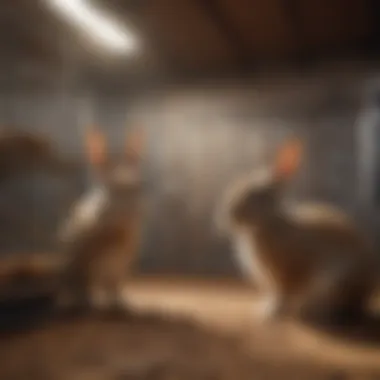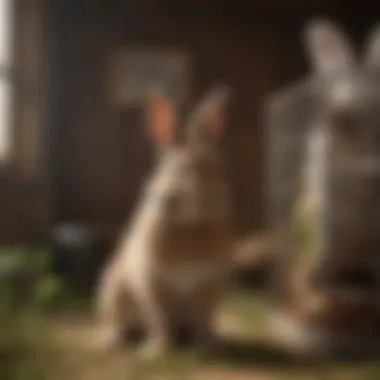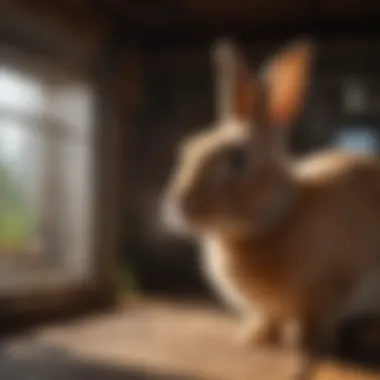Choosing the Best Cage for Two Rabbits: A Comprehensive Guide


Intro
Selecting a cage for two rabbits is not a trivial task. It's an undertaking that requires understanding their needs and behaviors. When rabbits are to share a living space, it becomes even more crucial to ensure that the environment is adequate for both. An appropriate cage fosters not only physical health but also emotional well-being for these social creatures. This guide will elaborate on the critical aspects one needs to consider in order to make an informed choice.
Animal Overview
Common Names
Rabbits are commonly known as bunnies or domesticated rabbits. They are popular pets in many households.
Scientific Classification
The domestic rabbit belongs to the family Leporidae within the order Lagomorpha, specifically classified as Oryctolagus cuniculus.
Geographic Range
Domesticated rabbits have a wide geographic distribution. They are found all over the world due to their popularity as pets.
Behavior and Social Structure
Social Behavior
Rabbits are inherently social animals. They thrive in the company of their own kind and often develop strong bonds with each other. When housing two rabbits, it is important to consider their social dynamics. Proper introductions and enough space can help prevent conflicts.
Communication
Communication among rabbits includes a variety of sounds and body language. They thump their hind legs to signal danger or express annoyance. Whining, grunting, and soft purring sounds can indicate contentment or a desire for attention.
Mating and Reproduction
Mating can be a complex aspect of rabbit behavior. Neutering or spaying is often recommended to prevent unwanted litters and reduce aggressive tendencies. It is also beneficial for health, sometimes extending the life of the rabbit.
Habitat and Ecosystem
Natural Habitat
In the wild, rabbits typically inhabit meadows, woods, forests, grasslands, and other habitats where they can burrow and hide from predators. This instinct to burrow should also be acknowledged when creating a cage environment.
Food Sources and Diet
Rabbits are herbivores and require a diet rich in fiber. Hay should make up the majority of their intake, supplemented with fresh vegetables and pellets. It's crucial that their cage allows for access to food and fresh water at all times.
Role in Ecosystem
Rabbits play an important role in their ecosystem. As herbivores, they contribute to plant growth by controlling the types of vegetation. Their burrowing habits also facilitate soil aeration which benefits plant life.
Understanding the complex needs of rabbits will lead to a better choice in housing. An informed decision promotes a healthier and more fulfilling life for these animals.
Prelude
A properly chosen cage can significantly influence a rabbit's behavior and health. A spacious and safe home not only encourages natural behaviors but also reduces stress. This article highlights several key considerations: the necessary space for two rabbits, the types of cages available, and what materials are best suited for their safety and comfort.
Furthermore, understanding how to maintain an optimal living environment includes recognizing the importance of ventilation, temperature control, and clean upkeep practices. This knowledge empowers rabbit owners to create a nurturing space. By following this guide, one can ensure that rabbits live in an ideal setting that promotes their physical and mental well-being.
Proper housing is more than just a cage; it’s about enriching the lives of our furry friends.
The forthcoming sections will delve deeper into these crucial elements, providing detailed insights. This groundwork will help equip pet owners to make informed decisions, fostering a loving and supportive habitat for their rabbits.
Importance of Proper Housing


Proper housing for two rabbits is critical for their overall well-being. When housed correctly, rabbits exhibit positive behaviors and maintain good health. A proper cage fosters a sense of security, allowing them to explore their environment and express their natural instincts. It is essential to consider multiple factors that contribute to the ideal living space for these pets.
Impact on Rabbit Behavior
Rabbit behavior is significantly influenced by their living conditions. An inadequate cage may lead to stress, anxiety, or even aggressive tendencies. For example, rabbits that feel confined may display destructive behaviors, such as chewing on cage materials or attempting to escape. On the other hand, a spacious and well-designed cage allows rabbits to engage in healthy play and socialize with each other.
Some key behavioral signs linked to housing conditions include:
- Hiding: Rabbits often seek refuge in small spaces. A proper cage should include hiding spots to help them feel secure.
- Exploring: Curiosity is a natural trait in rabbits. The more they have to explore, the more fulfilled they feel.
- Grooming: Stress can lead to over-grooming or fur loss. A comfortable environment promotes a balanced grooming routine.
Offering an enriching environment is necessary for rabbits to thrive and exhibit positive behaviors. This involves providing adequate space, various textures, and safe toys for stimulation.
Health Implications
The health of rabbits relies heavily on their housing situation. A cage that meets their needs minimizes the risk of health issues. For instance, poor ventilation may lead to respiratory problems, while inadequate space can lead to obesity from lack of exercise.
Remember these health factors when considering cage options:
- Infections: A dirty cage can become contaminated, leading to severe infections. Regular cleaning routines are vital.
- Nutrition: Access to proper feeding areas within the cage helps maintain a balanced diet. An ill-placed feeding station can contribute to unhealthy eating habits.
- Activity level: Lack of space can inhibit movement and play, leading to joint issues and lethargy.
In summary, proper housing is not just a preference; it plays a fundamental role in ensuring rabbits' physical and mental health. By understanding the significance of proper housing, pet owners can make informed decisions that promote a high quality of life for their rabbits.
Key Factors to Consider
Choosing the right cage is crucial for the well-being of your rabbits. Several key factors influence the decision-making process. These factors not only affect the comfort of the rabbits but also their overall health and behavior. In this section, we will delve into important aspects like space requirements, cage types, materials, and ventilation.
Space Requirements
The dimensions of the cage play a significant role in the happiness of your rabbits. Adequate space allows them to move around freely, promoting physical health and reducing stress. Two rabbits should have enough room to hop, play, and rest without feeling cramped. A minimum space requirement is often recommended, but the more room they have, the better it is for their mental and physical well-being. Larger cages facilitate more social interaction between the rabbits and encourage natural behaviors that are vital for their overall happiness.
Cage Type
When considering cage types, there are three main categories to explore. Each type has its own features that can suit different needs and preferences of rabbit owners. Choosing the right type enhances both functionality and comfort for your pets.
Standard Cages
Standard cages are one of the most common options for rabbit housing. They are often easy to assemble and come in various sizes. A key characteristic of standard cages is their straightforward design, which makes them accessible for many pet owners. The ease of cleaning is an additional benefit, enabling owners to maintain hygiene without much hassle. However, these cages may lack vertical space, which can limit the rabbits' exploration.
Multi-Level Cages
Multi-level cages offer an advantageous alternative for housing rabbits. These structures provide different levels that rabbits can access, encouraging climbing and exploring. A key aspect of multi-level cages is that they maximize the use of vertical space, which is beneficial for rabbits who enjoy jumping and moving around. The distinct levels allow for more separation of activities, such as eating, resting, and playing. Nonetheless, not all rabbits may be comfortable navigating multiple levels, especially if they are older or less active.
Custom-built Cages
Custom-built cages provide an ideal solution for those who want to tailor the living environment for their rabbits. These cages can be modified to meet specific space requirements or aesthetic preferences. A unique feature of custom-built solutions is their flexibility; they can incorporate various elements, such as additional shelving or built-in hiding spots. However, building a cage from scratch requires time, planning, and sometimes a financial investment. This option is best suited for dedicated rabbit owners who wish to create a specific habitat that caters to their pets' needs.
Material Selection
The materials used in constructing the cage significantly impact the safety and comfort of your rabbits. It's essential to consider the pros and cons of different materials.
Wired vs.
Solid Material
Wired cages are a popular choice in rabbit housing. A key characteristic of wired materials is their ventilation, which allows for optimal air circulation. Rabbits can also see out, which can reduce feelings of isolation. However, the wiring can sometimes lead to injuries if not designed properly. On the other hand, solid materials can provide better insulation and a more comforting environment but may limit airflow.
Safety Considerations
Safety considerations are paramount in ensuring a healthy living space for your rabbits. Key features include avoiding sharp edges, toxic materials, and ensuring that the bars are spaced appropriately to prevent escapes. A cage that prioritizes safety not only protects rabbits from potential harm but also provides peace of mind for the owner. Tanks or cages made from non-toxic materials are especially beneficial, preventing health issues related to chemical exposure.


Ventilation and Temperature Control
Proper ventilation and temperature control are critical to maintaining a suitable environment for your rabbits. A good ventilation system helps ensure fresh air is circulating within the cage. This reduces the buildup of odors and improves overall air quality. Additionally, monitoring the temperature is important to avoid extremes that can stress rabbits. Too much heat can lead to overheating, which is dangerous for their health. Conversely, exposure to cold drafts can also pose a risk. Therefore, strategically positioning the cage in an area that avoids direct sunlight while allowing for air circulation is essential.
Recommended Cage Sizes
The size of the cage that you choose for your rabbits is crucial in ensuring their well-being. The recommended cage sizes for two rabbits are not merely guidelines; they set the stage for the animals' behavior, health, and overall quality of life. A spacious environment allows rabbits to express their natural behaviors like hopping, digging, and playing. This can lead to healthier, happier pets and reduces the chances of stress-related illnesses. Selecting the right dimensions should consider both the immediate needs and the long-term comfort of the rabbits.
Minimum Dimensions for Two Rabbits
When housing two rabbits, minimum dimensions are essential to provide them with the basic comfort they need. The generally accepted minimum size for a cage housing two medium-sized rabbits is approximately 6 feet long by 2 feet deep and 2 feet high. This gives them room to stretch out, stand on their hind legs, and explore without feeling cramped.
The dimensions should be larger for larger breeds. If the rabbits are smaller or dwarf breeds, slightly less space may be acceptable. However, ensuring they have enough space to move is imperative to avoid behavioral issues or physical health problems.
It's important to note that bigger is always better. When in doubt, opt for a larger cage.
Considerations for Minimum Dimensions
- Rabbit Breed: Age and breed affect how much space is necessary. Bigger breeds naturally require more room.
- Activity Level: Some rabbits are more active than others. Higher energy rabbits benefit greatly from spacious areas.
- Separation: In some cases, rabbits may need separate spaces for feeding and resting, influencing cage design and dimensions.
Optimal Space for Activity
Beyond just the minimum requirements, considering optimal space for rabbits is crucial for their well-being. A more generous space, ideally around 8 feet long by 3 feet deep and 3 feet high, allows rabbits the freedom to engage in more physical activity.
Optimal sizes facilitate the natural movements of rabbits, enabling them to run, jump, and hop. This can lead to reduced stress, improved socialization, and mental stimulation. Furthermore, providing ample space reduces the chance of dominant behaviors, especially if the rabbits are not spayed or neutered.
Key Benefits of Optimal Space
- Enhanced Social Interactions: Rabbits thrive in social settings. More space allows them to interact more positively.
- Improved Health: A larger area encourages physical exercise, reducing the risk of obesity and promoting overall health.
- Behavioral Benefits: Boredom can lead to destructive behavior. An optimally sized cage offers enough room for enrichment and activity.
When choosing a cage for your rabbits, think about their needs and behaviors. Selecting a cage that is not merely functional but also spacious will greatly enhance the lives of your rabbits.
Essential Cage Accessories
Selecting the right cage for your rabbits is only one part of the equation. Accessories play a significant role in creating a comfortable, engaging, and safe environment for your pets. Essentials enhance their living space and contribute to their overall wellbeing. Careful consideration of these accessories can ensure that your rabbits lead happy lives.
Hiding Spaces
Hiding spaces are crucial for rabbits. These animals are prey by nature, so having an area where they can feel secure is essential. A hiding spot offers not just safety, but also a place for rest. Enclosed areas can reduce stress and provide a sense of privacy.
There are many options for hiding places. You can consider wooden tunnels, cardboard boxes, or specially designed rabbit houses. It's important to ensure the hiding space is large enough for both rabbits. They should be able to enter and exit comfortably. Also, avoid sharp edges and toxic materials.
Feeding Stations
An effective feeding station is vital for the health of your rabbits. A clean, organized area encourages proper eating habits. Place food and water in separate containers. This helps avoid contamination and keeps the area cleaner.
Consider using heavy bowls that cannot be easily flipped. Rabbits tend to move their dishes around, and heavy bowls will stay in place. Position the feeding station away from litter boxes and hiding spots. This separation encourages a hygienic environment and ensures your rabbits are comfortable while they eat.
Litter Boxes
Litter boxes are essential in keeping the cage clean and odor-free. Choosing the right type influences rabbit behavior and comfort. Opt for a shallow box to allow easy access. Fill it with safe, non-toxic litter material. Avoid clumping litter as it can be harmful if ingested.
Regular cleaning of the litter box prevents health issues. Daily maintenance is necessary to remove soiled litter and promote a hygienic living space. Additionally, placing the litter box in a corner can help your rabbits understand its purpose quickly.
Toys and Enrichment
Rabbits need mental stimulation and physical activity. Toys and enrichment items provide both. Chew toys, for example, keep their teeth healthy and help satisfy their natural need to gnaw. Look for products made from safe materials, such as untreated wood or cardboard.
Interactive toys also encourage play. Consider items that can be moved or rearranged. This type of engagement mimics a more natural environment and ensures your rabbits remain active and entertained. Rotate toys regularly to keep things fresh and inviting.


Maintenance and Cleaning
Proper maintenance and cleaning of a rabbit's cage is essential for several reasons. Maintaining a clean environment prevents the buildup of waste, which can lead to health issues for the rabbits. Regular cleaning also helps in reducing smells and keeping the living space hygienic. Additionally, proper maintenance reflects the owner's commitment to their pet's well-being, ultimately affecting the rabbits’ behavior and comfort.
Rabbits, being naturally clean animals, benefit from a tidy space. In a clean cage, they can feel secure and relaxed. Unclean conditions can cause stress, which may lead to undesirable behaviors such as chewing on cage bars or littering outside their designated area. Thus, maintenance and cleaning are not just about aesthetics but about cultivating a healthy habitat for the rabbits.
Routine Cleaning Practices
Routine cleaning practices should be tailored to meet the needs of both the rabbits and their owners. It is advisable to establish a regular cleaning schedule to ensure that the cage remains in optimal condition.
- Daily Tasks:
- Weekly Tasks:
- Monthly Tasks:
- Remove uneaten food and any droppings.
- Spot clean soiled areas.
- Refresh bedding materials as necessary to keep the area comfortable.
- Remove all bedding and replace it with fresh material.
- Thoroughly clean the cage surfaces with warm water and mild soap.
- Inspect toys and accessories for cleanliness; wash if needed.
- Disassemble and scrub down the entire cage, ensuring all corners are addressed.
- Wash any fabric items in the cage, like blankets or resting pads.
- Check for wear and tear and replace items as necessary.
Regular attention to these tasks will contribute significantly to the overall health and comfort of the rabbits.
Selecting Safe Cleaning Products
Choosing the right cleaning products is vital. Some common household cleaners contain chemicals that might be harmful to rabbits. Therefore, it is essential to select safe options when maintaining the cage.
- Natural Cleaners: Consider using vinegar and baking soda as effective alternatives. Both can clean surfaces and neutralize odors without posing a risk to the rabbits.
- Avoid Toxic Chemicals: Stay away from products containing bleach, ammonia, or any harsh detergents. These substances can cause respiratory problems or skin irritation.
- Rinsing: Always rinse cage surfaces after cleaning to remove any residue that may remain.
By investing time in routine maintenance and using safe cleaning products, owners contribute to the overall health and happiness of their rabbits.
Proper cleaning and maintenance will not only enhance the living conditions of the rabbits but also ensure that they thrive in a safe and pleasant environment.
Integrating an Outdoor Option
Integrating an outdoor option for housing two rabbits offers a range of advantages that enhance their quality of life. The ability to experience natural elements can significantly improve their well-being. Outdoor runs provide not only fresh air and sunlight but also encourage natural behaviors such as hopping and exploring. This section delves into the specific benefits of outdoor enclosures and how to prepare these spaces appropriately to ensure safety and comfort for your rabbits.
Benefits of Outdoor Runs
Outdoor runs present multiple benefits for rabbits, making them an essential component of their habitat. First, the exposure to natural light plays a crucial role in their overall health. Sunlight helps rabbits synthesize vitamin D, which is vital for bone health. Furthermore, outdoor environments tend to be richer in sensory stimulation compared to indoor cages. The sounds, smells, and sights of nature can reduce stress and encourage playfulness.
Another significant benefit is the opportunity for exercise. Rabbits are active creatures requiring ample space to run and jump. Outdoor runs enable them to move freely, promoting cardiovascular health and preventing obesity. Additionally, the act of exploring stimulates their curiosity and enhances their mental well-being.
Lastly, an outdoor setting allows for natural foraging behaviors. By providing safe grass or other edible plants, owners can create an enriching environment that mimics their wild counterparts. This not only encourages natural behavior but can also provide freshness to their diet.
Preparing Outdoor Spaces
When preparing outdoor spaces for your rabbits, several key considerations must be taken into account to ensure their safety and comfort. First and foremost, the enclosure must be secure. Use materials like heavy-duty wire mesh to prevent potential predators from accessing your pets and to keep them from escaping.
Next, consider shade and protection from harsh weather conditions. Outdoor rabbits need areas where they can seek shelter from direct sunlight in summer, as well as protection from rain or wind. A simple structure, like a rabbit hutch, can provide a safe space where they can retreat as needed.
It's also vital to ensure the area is free from harmful plants or chemicals. Research which plants are toxic to rabbits and clear any that might pose a risk. The ground should also be checked for sharp objects that could cause injury.
Finally, regularly monitor your rabbits while they are using the outdoor space. Supervision helps to detect any potential signs of distress or health issues quickly, ensuring that your rabbits remain safe and healthy while they enjoy their outdoor experience.
Integrating an outdoor option not only increases the living space for your rabbits but also enhances their overall health and happiness, creating a balanced living environment.
Closure
Choosing the right cage for two rabbits is crucial. A well-selected cage fosters well-being and happiness, affecting both behavior and health. This article has laid out significant factors to consider, from spatial needs to materials and necessary accessories. Each of these elements contributes to creating a safe environment for rabbits.
It's essential to remember that rabbits thrive in spacious areas. An adequate size allows them to hop freely and interact naturally with each other. This choice not only fulfills their physical activity needs but also their social interaction requirements.
Moreover, the correct cage type plays a vital role. Options like multi-level cages provide vertical space for playing and exploring, which can enhance their living experience. Material choice cannot be overlooked either. Selecting non-toxic, easy-to-clean materials ensures the safety of the rabbits and maintains a hygienic space.
The inclusion of essential accessories, such as hiding spots, proper feeding stations, and engaging toys, elevates their comfort levels. Each rabbit needs a space where they can retreat and feel secure. A well-planned cleaning routine solidifies a lasting and healthy habitat.
In summary, the conclusion drawn from this comprehensive guide emphasizes that thoughtful consideration in choosing a cage leads to optimal care for two rabbits. Pet owners must prioritize their needs. It promotes not only health but also the enrichment of their lives, creating a positive and fulfilling environment. By following the guidelines in this article, rabbit owners can ensure they are providing the best possible living conditions for their pets.







